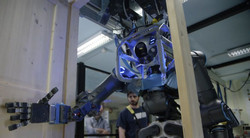WALK-MAN sets the bar high for DARPA’s Robotics Challenge Finals
Nowadays there seems to be a robot for doing just about anything, from dancing to playing ping pong or the trumpet. But as technology evolves, engineers are now trying to develop a new generation of robots capable of helping in situations where humans can’t. The WALK-MAN robot was built for this very purpose, to seamlessly operate in environments damaged by natural or man-made disasters. Jointly created by the Italian Institute of Technology, the University of Pisa, the Swiss Federal Institute of Technology of Lausanne, the Catholic University of Louvain and the Karlsruhe Institute of Technology, the WALK-MAN robot displays a range of unprecedented skills in robotics. A project video published last week shows how the robot’s dexterity and strength allow it to make Shaolin-inspired gestures, turn heavy valves, open doors and drive a car. But that’s not it: WALK-MAN can of course walk, crawl over uneven terrain, move heavy masonry or manipulate pneumatic drills – and it can do all of this autonomously or by means of a remote control. The robot can in fact work autonomously for an hour thanks to its embedded battery. To achieve this result, the consortium had to bring current walking and locomotion capabilities of humanoid systems to another level. By using its hands, arms, legs, feet, trunk, and making use of surrounding elements such as handrails, walls and furniture, the WALK-MAN robot can walk through cluttered, crowded spaces and maintain its balance as it runs into other objects or people. The robot’s hands have also been built with a high sensitivity to detail, with a human-inspired hand design that combines robustness and adaptability to perfectly grasp and manipulate hand tools. Perception-wise, WALK-MAN’s head features a stereo vision system, a rotating 3D laser scanner and a depth camera for 3D mapping and sensing. It also integrates colour cameras which provide it with additional sight of the world around it and facilitate navigation. The DARPA challenge Already acknowledged for its innovative aspects, the 1.85 metre, 100 kilo humanoid robot will have the challenging task of representing the EU at the US Defense Advanced Research Projects Agency (DARPA)’s Robotics Challenge Finals on 5 and 6 June 2015. The challenge’s ultimate goal is to enable future robots, in tandem with humans, to perform the most hazardous activities in disaster zones, thereby reducing casualties and saving lives. WALK-MAN already successfully passed the trials of the DARPA challenge in December 2014. To be crowned as the winner, it will first have to face competition from 24 other teams from the US, Japan, Germany, China and South Korea. The winner will be the team with the robot showcasing the best ability to maneuver in degraded environments, manipulate tools designed for humans and make decisions in partial autonomy based on operator command and sensor inputs, all this while being easy to operate for people with no robotics training. If successful, the WALK-MAN team will win $3.5 million (EUR 3.1 million) in prizes. For further information, please visit: WALK-MAN http://www.walk-man.eu/
Countries
Italy



